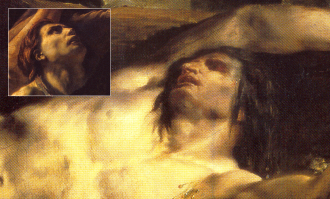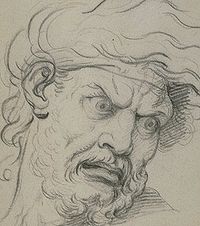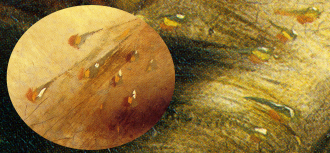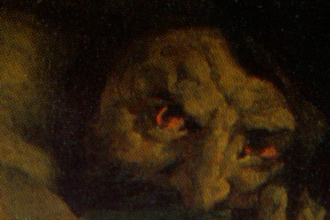
The Barque of Dante
Encyclopedia
The Barque of Dante, sometimes known as Dante and Virgil in Hell, is the first major painting by the French artist Eugène Delacroix
, and is one of the works signalling a shift in the character of narrative painting from Neo-Classicism towards the Romantic movement
. It was completed in time for the opening of the Salon of 1822 and currently hangs in the Musée du Louvre
, Paris.
The painting is loosely based on fictional events taken from canto eight of Dante’s
Inferno
. A leaden, smoky mist and the blazing City of the Dead
form the backdrop against which the poet Dante endures a fearful crossing of the River Styx
. He is steadied by the learned poet of antiquity
Virgil
as they plough through waters heaving with tormented souls.
The arrangement of figures is for the most part compliant with the tenets of the cool, reflective Neo-Classicism that had dominated French painting for nearly four decades. There is a group of central upright figures, and a rational arrangement of subsidiary figures, all in horizontal planes, and observing studied poses.
 The Barque of Dante was an artistically ambitious work, and although the composition is conventional, the painting in some important respects broke unmistakably free of the French Neo-Classical tradition.
The Barque of Dante was an artistically ambitious work, and although the composition is conventional, the painting in some important respects broke unmistakably free of the French Neo-Classical tradition.
The smoke to the rear and the fierce movement of the garment in which the oarsman Phlegyas
is wrapped indicate a strong wind, and most of the individuals in the painting are facing into it. The river is choppy and the boat is lifted to the right, a point at which it is twisted toward the viewer. The party is driven to a destination known to be yet more inhospitable, by an oarsman whose sure-footed poise in the storm suggests his familiarity with these wild conditions. The city behind is a gigantic furnace. There is neither comfort nor a place of refuge in the painting’s world of rage, insanity and despair.
 The painting explores the psychological states of the individuals it depicts, and uses compact, dramatic contrasts to highlight their different responses to their respective predicaments. Virgil’s detachment from the tumult surrounding him, and his concern for Dante’s well-being, is an obvious counterpoint to the latter’s fear, anxiety, and physical state of imbalance. The damned
The painting explores the psychological states of the individuals it depicts, and uses compact, dramatic contrasts to highlight their different responses to their respective predicaments. Virgil’s detachment from the tumult surrounding him, and his concern for Dante’s well-being, is an obvious counterpoint to the latter’s fear, anxiety, and physical state of imbalance. The damned
are either rapt in a piercing concentration upon some mad and gainless task, or are else apparently in a state of total helplessness and loss. Their lining of the boat takes an up-and-down wave-like form, echoing the choppy water and making the foot of the painting a region of perilous instability. The souls to the far left and right are like grotesque bookend
s, enclosing the action and adding a claustrophobic
touch to the whole.
Delacroix wrote that his best painting of a head in this picture is that of the soul reaching with his forearm from the far side into the boat. Both Charles Le Brun
’s, La Colère of 1668, and John Flaxman
’s line engraving The Fiery Sepulchres, appearing as plate 11 in The Divine Poem of Dante Alighieri, 1807, are likely sources for this head.
The theatrical display of bold colours in the figures at the centre of the composition is striking. The red of Dante’s cowl
resonates alarmingly with the fired mass behind him, and vividly contrasts with the billowing blue about Phlegyas. The author Charles Blanc
noted the white linen on Virgil’s mantle, describing it as a ‘great wake up in the middle of the dark, a flash in the tempest’. Adolphe Loève-Veimars commented on the contrast between the colours used in Dante’s head, and in the depiction of the damned, concluding that all this ‘leaves the soul with I know not what fell impression’.
 The drops of water running down the bodies of the damned are painted in a manner seldom seen up to and including the early nineteenth century. Four different, unmixed pigments, in discretely applied quantities comprise the image of one drop and its shadow. White is used for highlighting, strokes of yellow and green respectively denote the length of the drop, and the shadow is red.
The drops of water running down the bodies of the damned are painted in a manner seldom seen up to and including the early nineteenth century. Four different, unmixed pigments, in discretely applied quantities comprise the image of one drop and its shadow. White is used for highlighting, strokes of yellow and green respectively denote the length of the drop, and the shadow is red.
Delacroix’s pupil and chief assistant of over a decade, Pierre Andrieu, recorded that Delacroix had told him the inspiration for these drops had come in part from the water drops visible on the nereids in Rubens’ The Landing of Marie de’ Medici at Marseilles, and that the drops on The Barque of Dante were Delacroix’s point of departure as a colourist. Lee Johnson
discussing these drops comments that “the analytical principle [Delacroix] applies of dividing into pure coloured components an object that to the average eye would appear monochrome or colourless, is of far-reaching significance for the future.”
 In a letter to his sister, Madame Verninac, written in 1821, Delacroix speaks of his desire to paint for the Salon the following year, and to ‘gain a little recognition’. In April 1822 he wrote to his friend Charles Soulier that he had been working hard and non-stop for two and a half months to precisely that end. The Salon opened on April 24, 1822 and Delacroix’s painting was exhibited under the title Dante et Virgile conduits par Phlégias, traversent le lac qui entoure les murailles de la ville infernale de Dité. The intense labour that was required to complete this painting in time left Delacroix weak and in need of recuperation.
In a letter to his sister, Madame Verninac, written in 1821, Delacroix speaks of his desire to paint for the Salon the following year, and to ‘gain a little recognition’. In April 1822 he wrote to his friend Charles Soulier that he had been working hard and non-stop for two and a half months to precisely that end. The Salon opened on April 24, 1822 and Delacroix’s painting was exhibited under the title Dante et Virgile conduits par Phlégias, traversent le lac qui entoure les murailles de la ville infernale de Dité. The intense labour that was required to complete this painting in time left Delacroix weak and in need of recuperation.
Critics expressed a range of opinions about The Barque of Dante. One of the judges at the Salon, Étienne-Jean Delécluze
, was uncomplimentary, calling the work ‘a real daub’ (une vraie tartouillade). Another judge, Antoine-Jean Gros
, thought highly of it, describing it a ‘chastened Rubens
’. An anonymous reviewer in Le Miroir expected Delacroix to become a ‘distinguished colourist’. One particularly favourable piece of criticism from up-and-coming lawyer Adolphe Thiers
received wide circulation in the liberal periodical Le Constitutionnel.
In the summer of 1822, the French State purchased the painting for 2000 Francs, and moved it to the Musée du Luxembourg
. Delacroix was delighted on hearing the news, although he feared the piece would be less admired for being viewed at close quarters. Some two year later he revisited the painting, reporting that it gave him much pleasure, but describing it as being insufficiently vigorous; a deficiency he had identified in the painting he was working on at the time, The Massacre at Chios
. The painting was moved in 1874—eleven years after the death of the artist—to its present location, the Musée du Louvre.
Eugène Delacroix
Ferdinand Victor Eugène Delacroix was a French Romantic artist regarded from the outset of his career as the leader of the French Romantic school...
, and is one of the works signalling a shift in the character of narrative painting from Neo-Classicism towards the Romantic movement
Romanticism
Romanticism was an artistic, literary and intellectual movement that originated in the second half of the 18th century in Europe, and gained strength in reaction to the Industrial Revolution...
. It was completed in time for the opening of the Salon of 1822 and currently hangs in the Musée du Louvre
Louvre
The Musée du Louvre – in English, the Louvre Museum or simply the Louvre – is one of the world's largest museums, the most visited art museum in the world and a historic monument. A central landmark of Paris, it is located on the Right Bank of the Seine in the 1st arrondissement...
, Paris.
The painting is loosely based on fictional events taken from canto eight of Dante’s
Dante Alighieri
Durante degli Alighieri, mononymously referred to as Dante , was an Italian poet, prose writer, literary theorist, moral philosopher, and political thinker. He is best known for the monumental epic poem La commedia, later named La divina commedia ...
Inferno
Inferno (Dante)
Inferno is the first part of Dante Alighieri's 14th-century epic poem Divine Comedy. It is followed by Purgatorio and Paradiso. It is an allegory telling of the journey of Dante through what is largely the medieval concept of Hell, guided by the Roman poet Virgil. In the poem, Hell is depicted as...
. A leaden, smoky mist and the blazing City of the Dead
Dis (Divine Comedy)
In Dante Alighieri's The Divine Comedy, the City of Dis encompasses the sixth through the ninth circles of Hell. The most serious sins are punished here, in lower Hell...
form the backdrop against which the poet Dante endures a fearful crossing of the River Styx
Styx
In Greek mythology the Styx is the river that forms the boundary between the underworld and the world of the living, as well as a goddess and a nymph that represents the river.Styx may also refer to:-Popular culture:...
. He is steadied by the learned poet of antiquity
Classical antiquity
Classical antiquity is a broad term for a long period of cultural history centered on the Mediterranean Sea, comprising the interlocking civilizations of ancient Greece and ancient Rome, collectively known as the Greco-Roman world...
Virgil
Virgil
Publius Vergilius Maro, usually called Virgil or Vergil in English , was an ancient Roman poet of the Augustan period. He is known for three major works of Latin literature, the Eclogues , the Georgics, and the epic Aeneid...
as they plough through waters heaving with tormented souls.
The arrangement of figures is for the most part compliant with the tenets of the cool, reflective Neo-Classicism that had dominated French painting for nearly four decades. There is a group of central upright figures, and a rational arrangement of subsidiary figures, all in horizontal planes, and observing studied poses.
Themes

The smoke to the rear and the fierce movement of the garment in which the oarsman Phlegyas
Phlegyas
Phlegyas , son of Ares and Chryse or Dotis, was king of the Lapiths in Greek mythology. He was the father of Ixion and Coronis, one of Apollo's lovers. While pregnant with Asclepius, Coronis fell in love with Ischys, son of Elatus. When a crow informed Apollo of the affair, he sent his sister...
is wrapped indicate a strong wind, and most of the individuals in the painting are facing into it. The river is choppy and the boat is lifted to the right, a point at which it is twisted toward the viewer. The party is driven to a destination known to be yet more inhospitable, by an oarsman whose sure-footed poise in the storm suggests his familiarity with these wild conditions. The city behind is a gigantic furnace. There is neither comfort nor a place of refuge in the painting’s world of rage, insanity and despair.

Damnation
Damnation is the concept of everlasting divine punishment and/or disgrace, especially the punishment for sin as threatened by God . A damned being "in damnation" is said to be either in Hell, or living in a state wherein they are divorced from Heaven and/or in a state of disgrace from God's favor...
are either rapt in a piercing concentration upon some mad and gainless task, or are else apparently in a state of total helplessness and loss. Their lining of the boat takes an up-and-down wave-like form, echoing the choppy water and making the foot of the painting a region of perilous instability. The souls to the far left and right are like grotesque bookend
Bookend
A bookend is an object that is designed to buttress, or support, an upright row of books. It is placed on either end to prevent books from falling over, such as in a half-filled bookshelf. Bookends are both utilitarian and, often, decorative. They are common in libraries and in homes...
s, enclosing the action and adding a claustrophobic
Claustrophobia
Claustrophobia is the fear of having no escape and being closed in small spaces or rooms...
touch to the whole.
Delacroix wrote that his best painting of a head in this picture is that of the soul reaching with his forearm from the far side into the boat. Both Charles Le Brun
Charles Le Brun
Charles Le Brun , a French painter and art theorist, became the all-powerful, peerless master of 17th-century French art.-Biography:-Early life and training:...
’s, La Colère of 1668, and John Flaxman
John Flaxman
John Flaxman was an English sculptor and draughtsman.-Early life:He was born in York. His father was also named John, after an ancestor who, according to family tradition, had fought for Parliament at the Battle of Naseby, and afterwards settled as a carrier or farmer in Buckinghamshire...
’s line engraving The Fiery Sepulchres, appearing as plate 11 in The Divine Poem of Dante Alighieri, 1807, are likely sources for this head.
The theatrical display of bold colours in the figures at the centre of the composition is striking. The red of Dante’s cowl
Cowl
This article is about the garment used by monks and nuns. For other uses, see Cowl or Cowling .The cowl is an item of clothing consisting of a long, hooded garment with wide sleeves. Originally it may have referred simply to the hooded portion of a cloak...
resonates alarmingly with the fired mass behind him, and vividly contrasts with the billowing blue about Phlegyas. The author Charles Blanc
Charles Blanc
Charles Blanc was a French art critic, brother of Louis Blanc. After the February Revolution of 1848, he was director of the department for the visual arts at the ministry of the interior...
noted the white linen on Virgil’s mantle, describing it as a ‘great wake up in the middle of the dark, a flash in the tempest’. Adolphe Loève-Veimars commented on the contrast between the colours used in Dante’s head, and in the depiction of the damned, concluding that all this ‘leaves the soul with I know not what fell impression’.
Water drops on the damned

Delacroix’s pupil and chief assistant of over a decade, Pierre Andrieu, recorded that Delacroix had told him the inspiration for these drops had come in part from the water drops visible on the nereids in Rubens’ The Landing of Marie de’ Medici at Marseilles, and that the drops on The Barque of Dante were Delacroix’s point of departure as a colourist. Lee Johnson
Lee Johnson (art historian)
Professor Lee Frederick Johnson, was an Art Historian and specialist in the works of the French nineteenth century painter Eugène Delacroix.- Early life and scholarship :...
discussing these drops comments that “the analytical principle [Delacroix] applies of dividing into pure coloured components an object that to the average eye would appear monochrome or colourless, is of far-reaching significance for the future.”
Background

Critics expressed a range of opinions about The Barque of Dante. One of the judges at the Salon, Étienne-Jean Delécluze
Étienne-Jean Delécluze
Etienne-Jean Delécluze was a French painter and critic.From 1797 on, he was a pupil of Jacques-Louis David, as he describes in his biography of David...
, was uncomplimentary, calling the work ‘a real daub’ (une vraie tartouillade). Another judge, Antoine-Jean Gros
Antoine-Jean Gros
Baron Antoine-Jean Gros , also known as Jean-Antoine Gros, was both a French History and neoclassical painter.-Early life and training:...
, thought highly of it, describing it a ‘chastened Rubens
Rubens
Rubens is often used to refer to Peter Paul Rubens , the Flemish artist.Rubens may also refer to:- People :Family name* Paul Rubens Rubens is often used to refer to Peter Paul Rubens (1577-1640), the Flemish artist.Rubens may also refer to:- People :Family name* Paul Rubens (composer) Rubens is...
’. An anonymous reviewer in Le Miroir expected Delacroix to become a ‘distinguished colourist’. One particularly favourable piece of criticism from up-and-coming lawyer Adolphe Thiers
Adolphe Thiers
Marie Joseph Louis Adolphe Thiers was a French politician and historian. was a prime minister under King Louis-Philippe of France. Following the overthrow of the Second Empire he again came to prominence as the French leader who suppressed the revolutionary Paris Commune of 1871...
received wide circulation in the liberal periodical Le Constitutionnel.
In the summer of 1822, the French State purchased the painting for 2000 Francs, and moved it to the Musée du Luxembourg
Musée du Luxembourg
Musée du Luxembourg is a museum in Paris, France. It occupies the east wing of the Palais du Luxembourg, whose matching west wing originally housed Ruben's Marie de' Medici cycle. Since 2000 it has been run by the French Ministry of Culture and the Senate and is devoted to temporary exhibitions...
. Delacroix was delighted on hearing the news, although he feared the piece would be less admired for being viewed at close quarters. Some two year later he revisited the painting, reporting that it gave him much pleasure, but describing it as being insufficiently vigorous; a deficiency he had identified in the painting he was working on at the time, The Massacre at Chios
The Massacre at Chios
The Massacre at Chios is the second major oil painting by the French artist Eugène Delacroix. The work is more than thirteen feet high, and shows some of the horror of the wartime destruction visited on the Island of Chios...
. The painting was moved in 1874—eleven years after the death of the artist—to its present location, the Musée du Louvre.
See also
- The Raft of the Medusa
- Dante And Virgil In Hell by William-Adolphe BouguereauWilliam-Adolphe BouguereauWilliam-Adolphe Bouguereau was a French academic painter. William Bouguereau was a traditionalist; in his realistic genre paintings he used mythological themes, making modern interpretations of Classical subjects, with an emphasis on the female human body.-Life and career :William-Adolphe...
, a painting using the same title.

